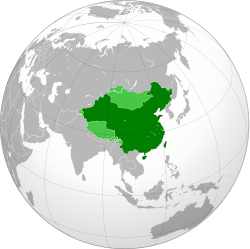
Back الحكومة القومية Arabic China bajo el Kuomintang (1925-1949) Spanish دولت ملی جمهوری چین Persian Gouvernement nationaliste French Pemerintahan Nasionalis ID Governo nazionalista Italian 国民政府 Japanese 국민정부 Korean အမျိုးသားရေးအစိုးရ Burmese Nationalistische regering (China) Dutch
Republic of China 中華民國 | |||||||||||
|---|---|---|---|---|---|---|---|---|---|---|---|
| 1925–1948 | |||||||||||
| Anthem: "National Anthem of the Republic of China" (1937–1948) | |||||||||||
National seal (1929–1949) | |||||||||||
 Land controlled by the Republic of China in 1945 shown in dark green; uncontrolled claims shown in light green. | |||||||||||
| Capital | |||||||||||
| Largest city | Shanghai | ||||||||||
| Official languages | Standard Chinese | ||||||||||
| Demonym(s) | Chinese | ||||||||||
| Government |
| ||||||||||
| President | |||||||||||
• 1928 (first) | Tan Yankai | ||||||||||
• 1943–1948 (last) | Chiang Kai-shek | ||||||||||
| Premier | |||||||||||
• 1928–1930 (first) | Tan Yankai | ||||||||||
• 1947–1948 (last) | Zhang Qun | ||||||||||
| Legislature | National Assembly | ||||||||||
| Control Yuan | |||||||||||
| Legislative Yuan | |||||||||||
| History | |||||||||||
• Established in Guangzhou | 1 July 1925 | ||||||||||
| 1926–1928 | |||||||||||
• Reset in Nanjing | 18 April 1927 | ||||||||||
| 1927–1936, 1946–1950 | |||||||||||
| 7 July 1937 – 2 September 1945 | |||||||||||
• Admitted to the United Nations | 24 October 1945 | ||||||||||
• Retrocession of Taiwan and the Pescadores | 25 October 1945 | ||||||||||
| 28 February 1947 | |||||||||||
| 25 December 1947 | |||||||||||
• Government of the Republic of China established | 20 May 1948 | ||||||||||
| Currency |
| ||||||||||
| ISO 3166 code | CN | ||||||||||
| |||||||||||
The Nationalist government, officially the National Government of the Republic of China,[a] refers to the government of the Republic of China from 1 July 1925 to 20 May 1948, led by the nationalist Kuomintang (KMT) party.
Following the outbreak of the Xinhai Revolution, revolutionary leader Sun Yat-sen was elected to be China's provisional president and founded the Provisional Government of the Republic of China. To preserve national unity, Sun ceded the presidency to military strongman Yuan Shikai, who established the Beiyang government. After a failed attempt to install himself as Emperor of China, Yuan died in 1916, leaving a power vacuum which resulted in China being divided into several warlord fiefs and rival governments. They were nominally reunified in 1928 under the Nanjing-based government led by Chiang Kai-shek, which after the Northern Expedition governed the country as a one-party state under the Kuomintang, and was subsequently given international recognition as the legitimate representative of China. The Nationalist government would then experience many challenges such as the Second Sino-Japanese War, and the Chinese Civil War. The government was in place until it was replaced by the current Government of the Republic of China in the newly promulgated Constitution of the Republic of China of 1948.
Cite error: There are <ref group=lower-alpha> tags or {{efn}} templates on this page, but the references will not show without a {{reflist|group=lower-alpha}} template or {{notelist}} template (see the help page).

